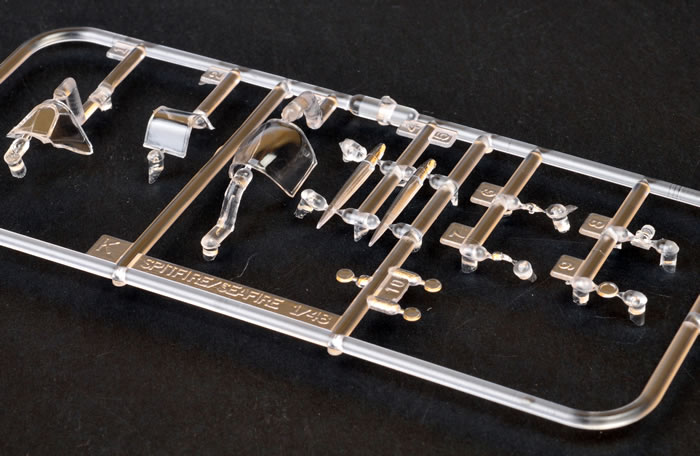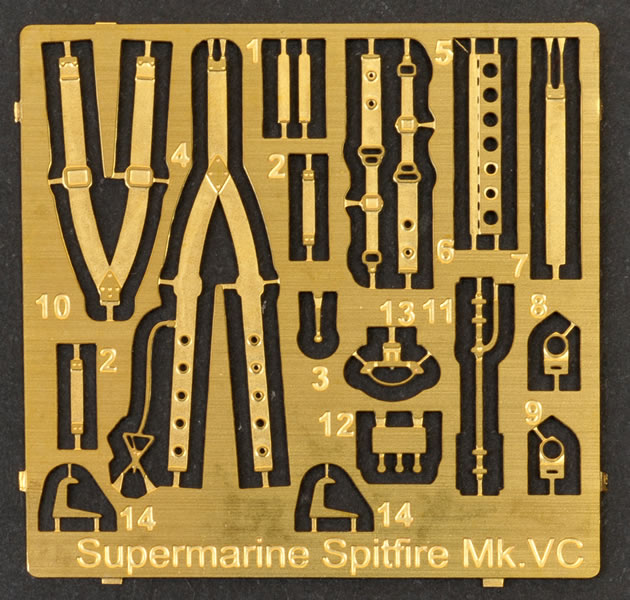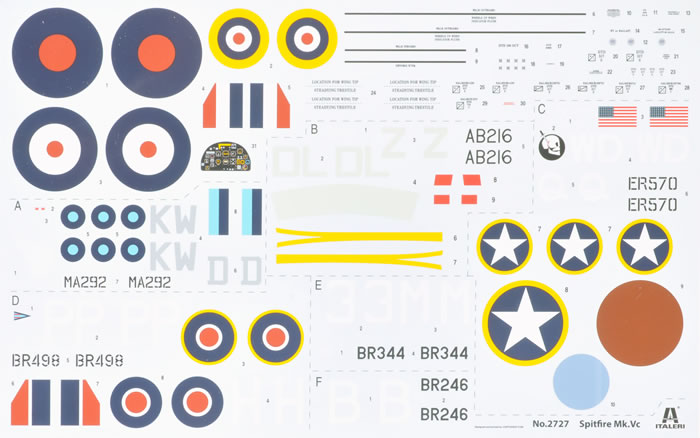|
Spitfire Mk.Vc

Italeri, 1/48 scale
S u m m a r y : |
Catalogue Number: |
Italeri Kit No.2727 - Supermarine Spitfire Mk.Vc |
Scale: |
1/48 |
Contents & Media: |
Approximately 94 grey plastic parts (14 unused); 12 clear plastic parts (5 unused); 1 fret of photo-etched brass parts; 1 decal sheet containing markings for 6 aircraft; 10 page fold-out instruction booklet including full colour painting and marking guide. |
Price: |
GBP £20.83 plus shipping available online from www.hannants.co.uk |
Review Type: |
First Look |
Advantages: |
Accurate kit; interesting range of marking options; high quality decals |
Disadvantages: |
Some descriptive errors in the painting and marking guide. Not really a disadvantage, but this is a limited run kit that will require some modeling skills to assemble. |
Conclusions: |
A welcome reissue of the most accurate 1/48 Spitfire Mk.Vc kit currently available, made even more attractive by the variety and number of marking options provided. |
Reviewed by
Brad Fallen

Zvezda's 1/48 Yak-3 is available online from Squadron.com
The Supermarine Spitfire Mk.Vc entered production in October 1941. The Mk.Vc’s universal wing could be fitted with a greater variety of guns than that of earlier Spitfires, as well as carry 250 and 500lb bombs. 2,467 Mk.Vc’s were built out of a total Mk.V production run of just under 6,500, and they were used on almost every front in World War 2.
This combination of large numbers and wide deployment saw Mk.Vcs finished in a wide variety of camouflage schemes, making the type one of the most attractive of all Spitfires as a modelling subject. It’s therefore surprising that until recently, the Mk.Vc was decidedly underdone in kit form. In 1/48, for example, you needed to tackle either Airfix’s hybrid Mk.Vc/Seafire IIIc kit – which combined new tool wings with parts from Airfix’s 1970s-vintage Mk.Vb kit – or use aftermarket resin wings to modify Tamiya’s Mk.Vb. Both approaches produced good results, but took more effort than would normally be required for a 1/48 Spitfire model.

Then in late 2008, Special Hobby and Classic Airframes released a new tool, joint venture Mk.Vc kit in two different boxings. The plastic and photo-etched parts in each kit were identical, with only the instructions and decals differing. The Special Hobby release focused on Malta-based Mk.Vcs, while the Classic Airframes kit – entitled ‘Yankee Spitfires’ – was reviewed and built on Hyperscale by Brett Green here. Brett concluded at the time that
"Classic Airframes' 1/48 scale Spitfire VC "Yankee Spitfire" is well detailed and features plenty of useful options. Bear in mind that this is a limited run kit so you will need to spend some extra time preparing parts, checking fit and making adjustments as required. This kit will not fall together - you will be using your modelling skills. Even so, based on my progress to date, the extra effort will result in an accurate, attractive kit of this important yet previously neglected Spitfire variant."
Special Hobby has since released two more Mk.Vc boxings – of Australian and Czech-operated aircraft – as well as two early Seafire kits, which are based on the same tooling. In 2009, Eduard recycled the plastic parts in Limited Edition format to produce a clipped-wing LF Mk.Vc kit, with the added bonus of die cut canopy masks, two large photo-etched frets, and a set of injection-moulded RAF crew figures.
Except for the Eduard release all of the boxings are still readily available, often for very reasonable prices. For 1/48 Mk.Vc fans, the past five years have been a case of going from famine to feast – and now Italeri is giving the Special Hobby/Classic Airframes plastic another outing, in the form of a Mk.Vc kit with markings for six aircraft from four different theatres.
Italeri’s 1/48 Spitfire Mk.Vc kit comes in a largish top-opening box adorned with crisp art of one of the marking options – the India-based KW-D/MA292 – taking off from a burning airstrip.
Inside the box are six sprues of mid-grey plastic parts: three larger sprues containing the main airframe and detailing components, and three small sprues holding the standard wingtips, de Havilland propeller and spinner, and Vokes tropical filter. These parts are identical in every respect to those in my Eduard and Special Hobby ‘Malta Defenders’ kits, while the Classic Airframes sprues differ only in that a Rotol rather than de Havilland propeller and spinner assembly is provided.
This similarity is good, because it means the Italeri parts are well moulded with very reasonable surface detail. The limited run nature of the plastic only becomes apparent when you examine the smaller parts, which have more flash and slightly softer detail than equivalent pieces in mainstream kits. However with careful cleaning up, and in some cases a little extra work (such as drilling out the lightening holes in the fuselage framework behind the seat), these parts will look fine. The instrument panel features accurate raised detail, and the shape of the pilot’s seat is good. Sprue gates are thin compared to those of many other limited run kits.
The optional parts from earlier boxings are also present here: three different wheel hubs, four different cannon bulge covers, several types of cannon barrels and caps, standard and clipped wingtips, and Vokes tropical filter and standard lower cowl. These options mean that if you don’t want to build any of the kit-supplied marking choices, you’ve got considerable leeway to search for an aircraft of your liking.
The clear parts are well moulded, thin and very transparent. The canopy is provided in three parts, so can be positioned open if you wish.

A small fret of photo-etched brass holds the pilot’s harness and a number of smaller cockpit parts.

The nine page fold-out instruction sheet (which is slightly longer and narrower in size than A4) contains a parts map, a clearly illustrated eight-step assembly guide, a full colour painting and marking guide with four view drawings of each aircraft, and a four view black and white stencil placement guide.
As good as the box contents look, this remains a limited run kit. Brett’s ‘Yankee Spitfires’ review provides 12 construction tips for modelers building the kit. While none of the issues are really problematic, this is clearly not a model for beginners. Italeri hints at this on the kit box and instructions, which describe the kit as a “model for adult collector age 14 and over”. However, I suspect that some buyers will be surprised at what they’ve got, particularly when they start construction.
Markings
The kit’s ‘super decals sheet’ contains markings for six different aircraft, which nicely capture the wide variety of schemes applied to Spitfire Mk.Vcs.

Details are as follows:
-
KW-D/MA292, flown by Flying Officer Lawrence Weggery of No.615 Squadron RAF, Dohazary, India, 1944. MA292 was finished in Dark Green and Dark Earth over Sky, with a white spinner, grey codes and two-tone blue SEAC national markings. Internet photos show the aircraft with contrasting areas of finish – overall quite shiny, but with heavy areas of dirt and/or weathering from foot traffic on the upper port wing root. In the photos I found MA292 was fitted with a Rotol propeller and spinner, rather than the de Havilland unit provided in the kit. MA292 was also sported a Vokes tropical filter, as did marking options C, E and F.
-
DL-Z/AB216, flown by Squadron Leader Robert “Bobby” Oxspring of No.91 “Nigeria” Squadron, RAF Hawkinge, United Kingdom, May 1942. This is the only Dark Green/Ocean Grey over Medium Sea Grey aircraft offered in this release, a testament to the variety of schemes Italeri has selected. Less impressive are the errors in Italeri’s instructions, with Oxspring referred to as ‘Oxpring’ and 91 Squadron misidentified as ‘291 Squadron’.
-
WD-Q/ER570, flown by Major Robert Levine of the 4th Fighter Squadron, 52nd Fighter Group, Twelfth Air Force, USAAF, Lajbala, Tunisia, 1943. 52nd FG Spitfires are popular modeling subjects, and this Middle Stone/Dark Earth/Azure Blue aircraft is likely to be no exception with its striking combination of markings. As with option A, photos show heavy weathering on the port wing root.
-
PP-H/BR498, flown by A/Wing Commander Peter Prosser Hanks, based at Luqa, Malta, 1942. Interpreting Malta Spitfire colours is a potential minefield, and BR498 is no exception. While there are several photos of this aircraft finished in Middle Stone and Dark Earth over Azure Blue or Light Mediterranean Blue, there is one well-known image of BR498 painted with a much darker, possibly single colour upper surface camouflage. Italeri has interpreted this finish as Non-Specular Blue Grey over Azure Blue. For some insights into Malta Spitfire camouflage, read Steven Eisenman’s recent review of Brian Cauchi’s ‘Malta Spitfire Vs – 1942: Their Camouflage and Markings’.
-
3-M/BR344, No.601 Squadron, Malta, 1942. This and the final option are also Malta-based Spitfires. Dark Green and Dark Earth over Sky camouflage are suggested as colours for this aircraft, although Middle Stone/Dark Earth/Azure Blue are also possibilities. What isn’t in doubt is the non-standard ‘wavy’ fuselage demarcation between the upper and lower camouflage colours, which while tricky to paint will result in a distinctive-looking model.
-
B/BR246, flown by Flying Officer Frank Jones of No.249 Squadron RAF, Malta, June 1942. BR246 was most likely Middle Stone and Dark Earth over Azure Blue. Distinctive features of this aircraft included a rectangle of lighter-coloured paint beneath the starboard fuselage serial (interpreted here as being Middle Stone), and a Vokes filter painted in Dark Earth rather than the undersurface camouflage colour.
The painting and marking guide is a highlight of the kit, with clear illustrations of each aircraft that leave no doubt about colours or decal placement. Colour call outs are in US Federal Standard numbers and Italeri Acrylics.
The decals are by Cartograf and look very good. Printing is crisp, with no obvious production errors. Registration appears to be perfect, including on the four-colour RAF fuselage roundels. There are a couple of oddities. The yellow wing leading edge stripes for option B are supplied as decals, but I would probably paint these; and the circular decal representing the overpainted RAF roundel on the starboard upper wing of option C is a peculiar colour, and looks a bit too red for my liking. Overall, however, the decals are excellent.
This is a welcome reissue of the most accurate 1/48 Spitfire Mk.Vc kit currently available. If you take your time and do lots of test fitting, you’ll end up with a good model. The wide range of marking options, and high quality decals, add to the kit’s appeal. If you are a Spitfire fan then you should have at least one boxing of this kit in your collection – and if you’re anything like me, you’ll find it hard to stop at just one.
Highly Recommended.
References:
Robert Humphreys, ‘The Supermarine Spitfire – A Comprehensive Guide for the Modeller, Part 1: Merlin Powered’ (SAM Publications, 2000)
Stewart Wilson, ‘Spitfire’ (Aerospace Publications, 1999)
Thanks to The Hobby Company Limited for the sample
Review Text Copyright © 2013 by Brad Fallen
Images Copyright © 2013 by Brett Green
Page Created 3 September, 2013
Last updated
4 September, 2013
Back to HyperScale Main Page
Back to Reviews Page

|
